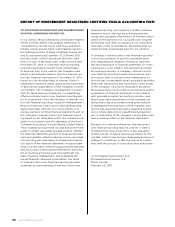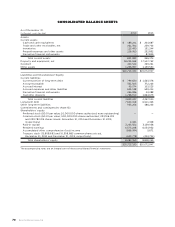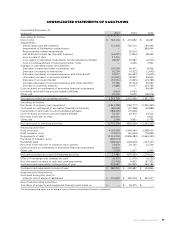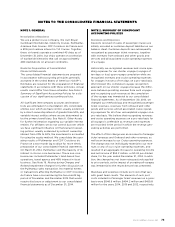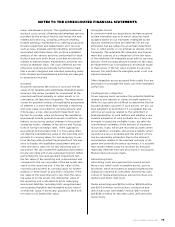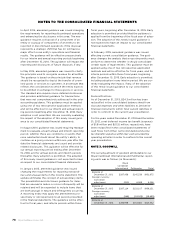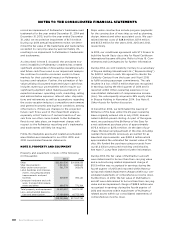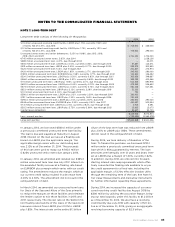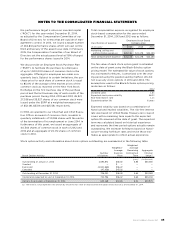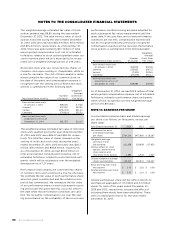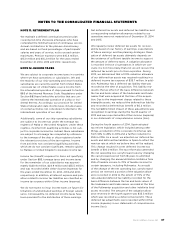Royal Caribbean Cruise Lines 2014 Annual Report Download - page 78
Download and view the complete annual report
Please find page 78 of the 2014 Royal Caribbean Cruise Lines annual report below. You can navigate through the pages in the report by either clicking on the pages listed below, or by using the keyword search tool below to find specific information within the annual report.
Royal Caribbean Cruises Ltd. 77
NOTES TO THE CONSOLIDATED FINANCIAL STATEMENTS
transactions are settled in United States dollars. Gains
or losses resulting from transactions denominated in
other currencies are recognized in income at each
balance sheet date.
Concentrations of Credit Risk
We monitor our credit risk associated with financial
and other institutions with which we conduct signifi-
cant business and, to minimize these risks, we select
counterparties with credit risks acceptable to us and
we seek to limit our exposure to an individual counter-
party. Credit risk, including but not limited to counter-
party nonperformance under derivative instruments,
our credit facilities and new ship progress payment
guarantees, is not considered significant, as we pri-
marily conduct business with large, well-established
financial institutions, insurance companies and export
credit agencies many of which we have long-term
relationships with and which have credit risks accept-
able to us or where the credit risk is spread out among
a large number of counterparties. As of December 31,
2014, we did not have any counterparty credit risk
exposure under our derivative instruments. As of
December 31, 2013, we had counterparty credit risk
exposure under our derivative instruments of approxi-
mately $92.5 million, which was limited to the cost of
replacing the contracts in the event of non-performance
by the counterparties to the contracts, all of which
are currently our lending banks. We do not anticipate
nonperformance by any of our significant counter-
parties. In addition, we have established guidelines
we follow regarding credit ratings and instrument
maturities to maintain safety and liquidity. We do not
normally require collateral or other security to support
credit relationships; however, in certain circumstances
this option is available to us.
Earnings Per Share
Basic earnings per share is computed by dividing net
income by the weighted-average number of shares of
common stock outstanding during each period. Diluted
earnings per share incorporates the incremental shares
issuable upon the assumed exercise of stock options
and conversion of potentially dilutive securities.
Stock-Based Employee Compensation
We measure and recognize compensation expense
at the estimated fair value of employee stock awards.
Compensation expense for awards and the related tax
effects are recognized as they vest. We use the esti-
mated amount of expected forfeitures to calculate
compensation costs for all outstanding awards.
Segment Reporting
We operate five wholly-owned cruise brands, Royal
Caribbean International, Celebrity Cruises, Azamara
Club Cruises, Pullmantur and CDF Croisières de France.
In addition, we have a 50% investment in a joint ven-
ture with TUI AG which operates the brand TUI Cruises.
We believe our global brands possess the versatility
to enter multiple cruise market segments within the
cruise vacation industry. Although each of our brands
has its own marketing style as well as ships and crews
of various sizes, the nature of the products sold and
services delivered by our brands share a common
base (i.e., the sale and provision of cruise vacations).
Our brands also have similar itineraries as well as
similar cost and revenue components. In addition,
our brands source passengers from similar markets
around the world and operate in similar economic
environments with a significant degree of commercial
overlap. As a result, our brands (including TUI Cruises)
have been aggregated as a single reportable segment
based on the similarity of their economic character-
istics, types of consumers, regulatory environment,
maintenance requirements, supporting systems and
processes as well as products and services provided.
Our Chairman and Chief Executive Officer has been
identified as the chief operating decision-maker and
all significant operating decisions including the alloca-
tion of resources are based upon the analyses of the
Company as one segment.
Information by geographic area is shown in the table
below. Passenger ticket revenues are attributed to
geographic areas based on where the reservation
originates.
Passenger ticket revenues:
United States
All other countries
Recent Accounting Pronouncements
In January 2014, amended guidance was issued
regarding the accounting for service concession
arrangements. The new guidance defines a service
concession as an arrangement between a public-
sector entity grantor and an operating entity under
which the operating entity operates and maintains
the grantor’s infrastructure for a specified period of
time and in return receives payments from the grantor
and or third-party user for use of the infrastructure.
The guidance prohibits the operating entity from
accounting for a service concession arrangement
as a lease and from recording the infrastructure used
in the arrangement within property, plant and equip-
ment. This guidance must be applied using a modi-
fied retrospective approach and will be effective for
our interim and annual reporting periods beginning
after December 15, 2014. Early adoption is permitted.
The adoption of this newly issued guidance is not
expected to have a material impact to our consoli-
dated financial statements.



